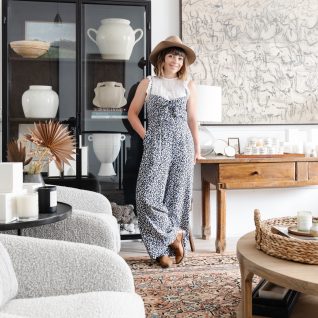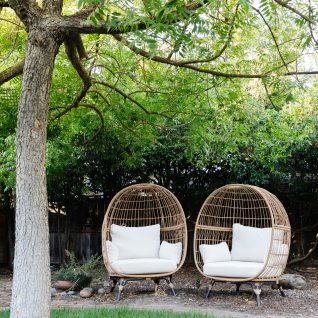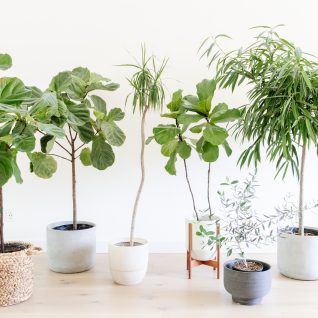Drum-roll please…….. ta-da! My first DIY furniture re-vamp is finally in the books! I am SO happy with the outcome. I leaped quite a few hurdles working on these chairs, and I may have doubted myself at one point, but boy, now that they're complete I can definitely pat myself on the back for a job well done! The only advice I have for you is this, try not to shoot-the-moon with your first DIY project. Re-vamping 4 rickety old antique chairs was certainly not the easiest first project, but with a little help and patience they're completely fabulous and unrecognizable!
Here's the before and after:
See how terribly beautiful and old these chairs were before? Each chair was filled with hundreds of old-school nails, which I had to pry out with a special tool since my hammer wasn't sharp enough to fit under the nail heads. Here's the step-by-step process of what I did to take these chairs from booty to loot:
Step 1: Remove Nails & Sand
I removed the nails from each chair with this guy. I would definitely recommend using this tool when removing any low-profile nails. I found it quite durable considering it was relatively economical. Next, I sanded each chair with medium grit sanding pads until the chair was smooth.
Step 2: Apply Wood Filler & Sand
First, I wiped the chair free from any sanding dust with a baby wipe. Then I took Elmer's wood filler and applied it to the holes left behind from removing the nails. I made sure to over-apply the wood filler, as it tends to shrink when it dries. I let the wood filler dry overnight, then I sanded the chairs again so the wood filler was flush with the chair.
Step 3: Prime & Sand
After I sanded the wood filler, I wiped the chair clean and free of dust with a baby wipe, and then I applied primer with a Purdy angled brush. I didn't get a very good pic of the primer I used, you can kinda see it in the background. I used Zissner primer with the brown label. This is a killer primer. It goes on thick and sands well. The only downer is it's a little stinky, so make sure you work with this stuff in a ventilated area. This primer is also offered in a spray-can, which I plan to use for the first time on one of my upcoming projects. I'll certainly let you know how they differ.
I let the primer dry and began working on the seats…
Step 4: Make your own seat!
I bought these chairs without seats, if you didn't notice this already :) which posed only a slight complication. Besides not owning a jig-saw, or some other weapon of choice to cut out a seat, I honestly didn't think the seat would be too complicated. On my first attempt, I bought a sheet of plywood about 1/4" thick, which turned out to be way too thin for a seat. I exchanged the wood for a thicker slab, about 3/4" thick, then turned to the contractor in my family to help cut out the seat. Unfortunately, because these chairs were originally constructed by hand, each had slightly different dimensions, which meant we had to cut out 4 different seat-forms.
To make the seat, first I cut out each seat form from cardboard, then traced it to the plywood, then used a jig-saw to cut out the seat. After the seat was cut out, I numbered the seat and chair so I would know which belonged to which for when it came time to mounting the seats.
Step 5: Spray paint, a Little bit of Distressing, and Poly
I have a big confession… I love white furniture! I love it like that eHaromony chick likes cats. Phew, I feel better that I shared. I live in my BF's house which is full of dark furniture and red decor.. don't get me wrong, it isn't bad, it's just not my taste. It feels so dark and wise in our house, I just want some youthful white furniture accented by sweet yellows and powder blues! So, please take it easy on me, it'll take me a while to move past painting things white.
What color did I choose for my chairs? White! Yum yum! Not just any white, Rust-Oleum's Heirloom white, in the spray can, which in person is exactly what you'd imagine, a subtle creamy off-white perfect for antique-y things like these chairs. I coated them twice, letting them dry completely between each coat.
I know these chairs have so much character on their own, I really felt I could bring them to their full potential with a little distressing. There are a few different techniques you can use to distress furniture, in this case I decided to use sand paper to add a few distressed details. Once the paint was completely dry, I softly rubbed the sand paper to a few edges and corners to expose the wood beneath. I did not go overboard, just a few edges here and there (sorry! I forgot to take a close up of the distressed details). Once I finished distressing, I wiped the chair free of dust with a damp cloth. Then, I took another cloth to apply the wipe-on poly. It's best to use a lint-free cloth, otherwise you'll be picking out little fibers and hairs from your piece. Also, I can't stress this enough, WEAR GLOVES. This stuff is a pain in the butt to get off your hands, and if you're like me, I hate using chemicals to remove other chemicals. I only applied one coat of poly, however the directions suggested more than one. It's your choice really.
Step 6: Foam, Batting & Upholstery
I decided these chairs should remain somewhat timeless. At the fabric store, it was a tie between a soft solid teal or the blue striped pattern you see above. Obviously you see which I fabric I took home. I tell ya, I can't get enough of a blue and white combo.
I placed medium-density foam on top of the plywood seat, then used a serrated kitchen knife to cut the foam in the form of the seat. Next I took 8oz batting and wrapped it around the foam, then stapled it to the seat using a staple gun. Lastly, I took the fabric, aligned and centered the stripes to go front-to back, wrapped the fabric around the batting and stapled the fabric to the seat. You want to give yourself extra fabric around the seat when measuring, about 3-4 inches. Folding the corners of the fabric was tricky. I really didn't want to see any folds from either angle, so I manged to fold and tuck the fabric on the corner of the foam seat, which made it nearly invisible!
Step 7: Securing the Seat to the Chair:
You want to get the seat nice and secure before drilling any holes. I used some clamps to secure the seat to the chair, with a rag under the clamp to add some padding. It was just a precaution, I didn't want to damage the chair in anyway. Then drilled 6 L-brackets to each chair, 2 brackets on two sides, 1 bracket on the another two sides.
Flip the chair over, and voilà!
She is so beautiful! Can you believe the transformation? I wish I could keep these for myself, but unfortunately I will be selling these chairs, but now that I've revamped these, I could certainly do it again when I finally get my own space to decorate!
What do you think of my first project??
)
)





Absolutely amazing- you have an incredible eye! How many are you selling and for how much?
beautiful…you are very talented
Are you serious? did you really turn that crappy old chair into that pretty and comfortable chair? I guess you did but it is still hard to believe. I am gonna try to do the same with my old furniture now!
We just picked up a beautiful table and six chairs for $100 and I have stripped two chairs so far….a full handful of staples for EACH chair. We noticed the previous owner had glued the seat to the frame with big globs of glue.
While I didn’t know how I was going to secure the seats, it wasn’t going to be with glue…lol.
This is so timely and I love how you explained the steps with the great photos!!!
I think my biggest problem is going to be to find just one fabric I like for the seats!
Thank you so much!